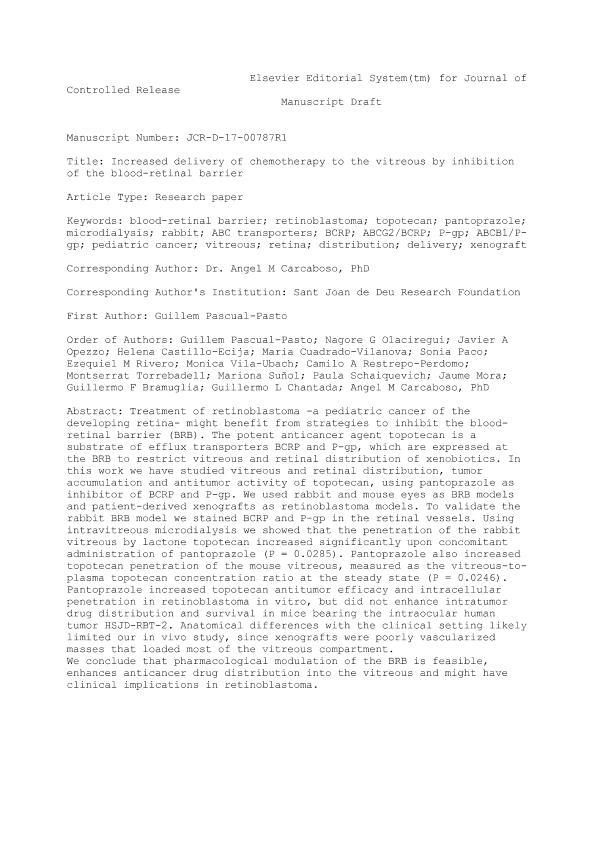Artículo
Increased delivery of chemotherapy to the vitreous by inhibition of the blood-retinal barrier
Pascual-Pasto, Guillem; Olaciregui, Nagore G.; Opezzo, Javier A. W.; Castillo Ecija, Helena; Cuadrado Vilanova, Maria; Paco, Sonia; Rivero, Ezequiel Mariano ; Vila Ubach, Monica; Restrepo Perdomo, Camilo A.; Torrebadell, Montserrat; Suñol, Mariona; Schaiquevich, Paula Susana
; Vila Ubach, Monica; Restrepo Perdomo, Camilo A.; Torrebadell, Montserrat; Suñol, Mariona; Schaiquevich, Paula Susana ; Mora, Jaume; Bramuglia, Guillermo Federico; Chantada, Guillermo Luis
; Mora, Jaume; Bramuglia, Guillermo Federico; Chantada, Guillermo Luis ; Carcaboso, Angel M.
; Carcaboso, Angel M.
 ; Vila Ubach, Monica; Restrepo Perdomo, Camilo A.; Torrebadell, Montserrat; Suñol, Mariona; Schaiquevich, Paula Susana
; Vila Ubach, Monica; Restrepo Perdomo, Camilo A.; Torrebadell, Montserrat; Suñol, Mariona; Schaiquevich, Paula Susana ; Mora, Jaume; Bramuglia, Guillermo Federico; Chantada, Guillermo Luis
; Mora, Jaume; Bramuglia, Guillermo Federico; Chantada, Guillermo Luis ; Carcaboso, Angel M.
; Carcaboso, Angel M.
Fecha de publicación:
10/2017
Editorial:
Elsevier Science
Revista:
Journal of Controlled Release
ISSN:
0168-3659
Idioma:
Inglés
Tipo de recurso:
Artículo publicado
Clasificación temática:
Resumen
Treatment of retinoblastoma -a pediatric cancer of the developing retina- might benefit from strategies to inhibit the blood-retinal barrier (BRB). The potent anticancer agent topotecan is a substrate of efflux transporters BCRP and P-gp, which are expressed at the BRB to restrict vitreous and retinal distribution of xenobiotics. In this work we have studied vitreous and retinal distribution, tumor accumulation and antitumor activity of topotecan, using pantoprazole as inhibitor of BCRP and P-gp. We used rabbit and mouse eyes as BRB models and patient-derived xenografts as retinoblastoma models. To validate the rabbit BRB model we stained BCRP and P-gp in the retinal vessels. Using intravitreous microdialysis we showed that the penetration of the rabbit vitreous by lactone topotecan increased significantly upon concomitant administration of pantoprazole (P = 0.0285). Pantoprazole also increased topotecan penetration of the mouse vitreous, measured as the vitreous-to-plasma topotecan concentration ratio at the steady state (P = 0.0246). Pantoprazole increased topotecan antitumor efficacy and intracellular penetration in retinoblastoma in vitro, but did not enhance intratumor drug distribution and survival in mice bearing the intraocular human tumor HSJD-RBT-2. Anatomical differences with the clinical setting likely limited our in vivo study, since xenografts were poorly vascularized masses that loaded most of the vitreous compartment. We conclude that pharmacological modulation of the BRB is feasible, enhances anticancer drug distribution into the vitreous and might have clinical implications in retinoblastoma.
Archivos asociados
Licencia
Identificadores
Colecciones
Articulos(SEDE CENTRAL)
Articulos de SEDE CENTRAL
Articulos de SEDE CENTRAL
Citación
Pascual-Pasto, Guillem; Olaciregui, Nagore G.; Opezzo, Javier A. W.; Castillo Ecija, Helena; Cuadrado Vilanova, Maria; et al.; Increased delivery of chemotherapy to the vitreous by inhibition of the blood-retinal barrier; Elsevier Science; Journal of Controlled Release; 264; 10-2017; 34-44
Compartir
Altmétricas



